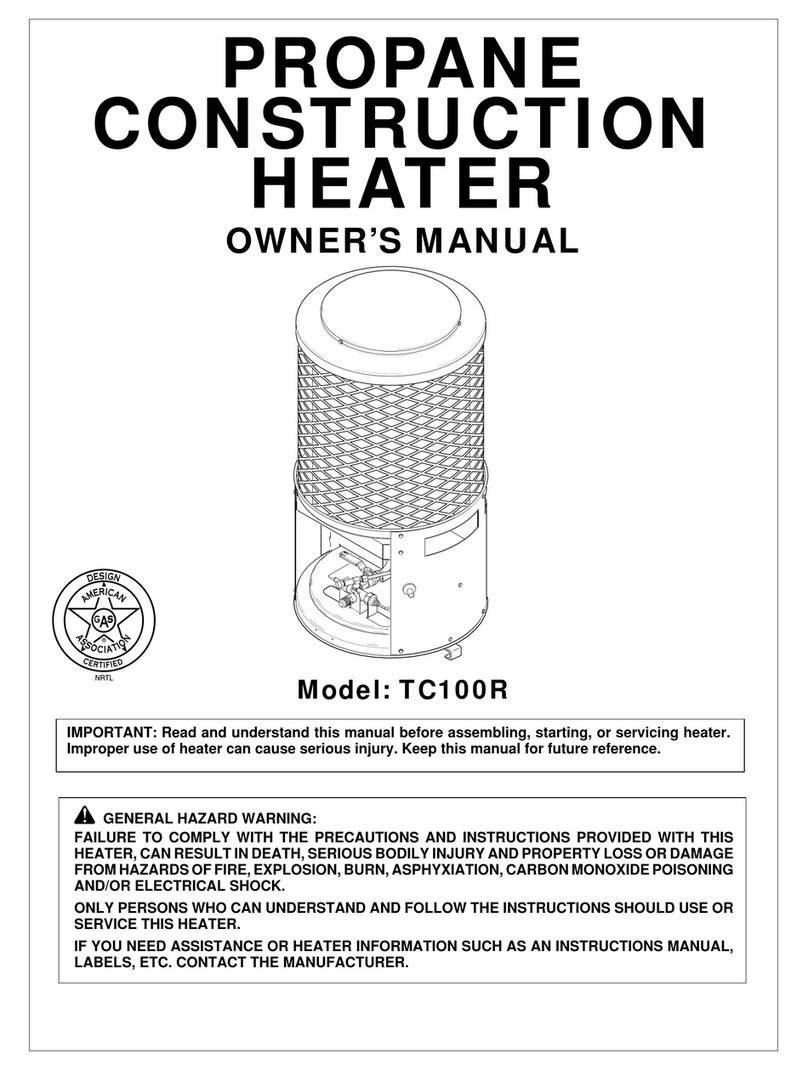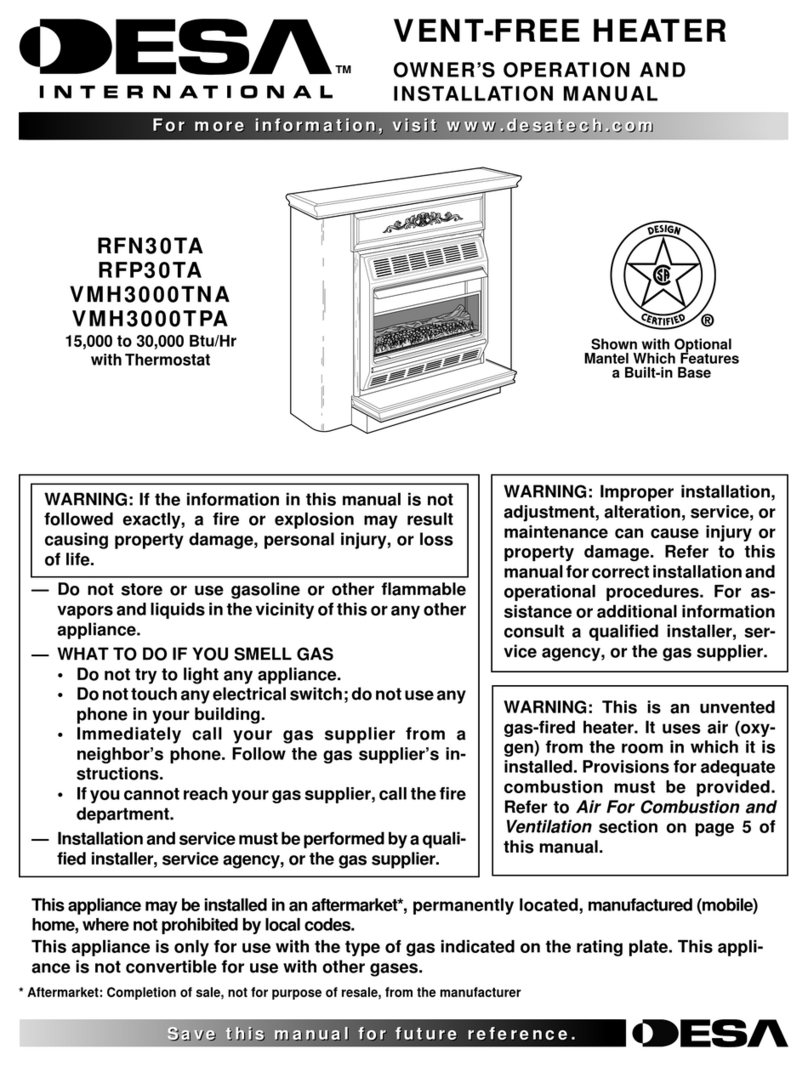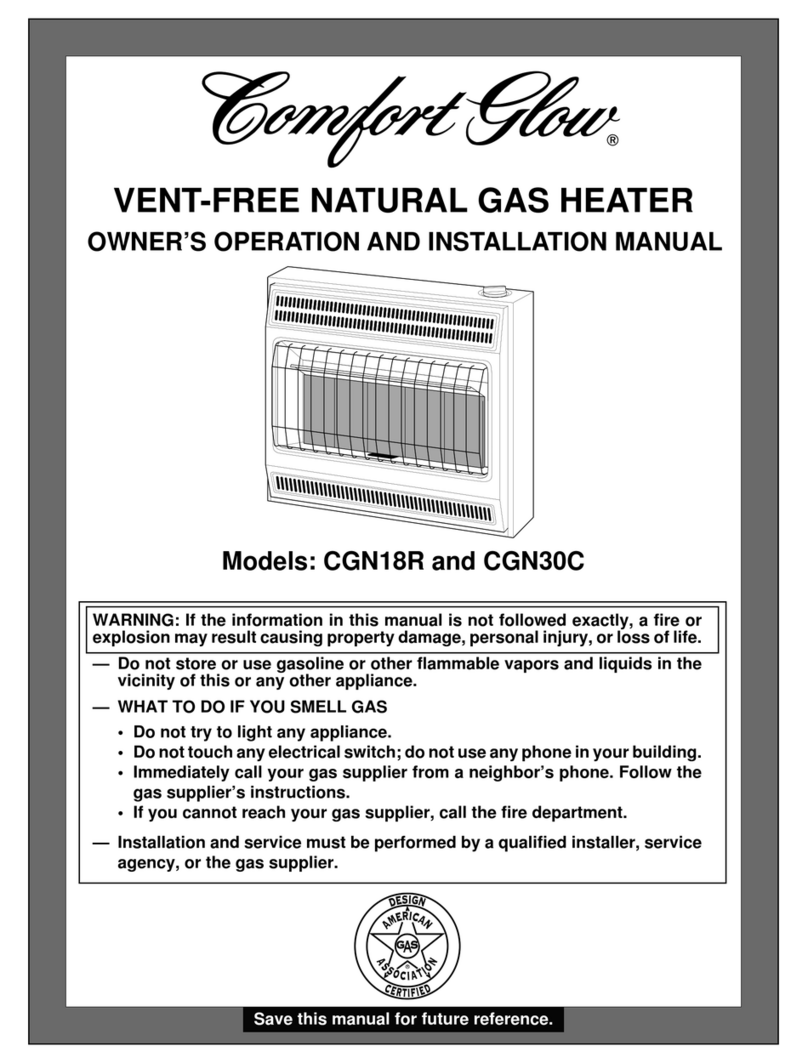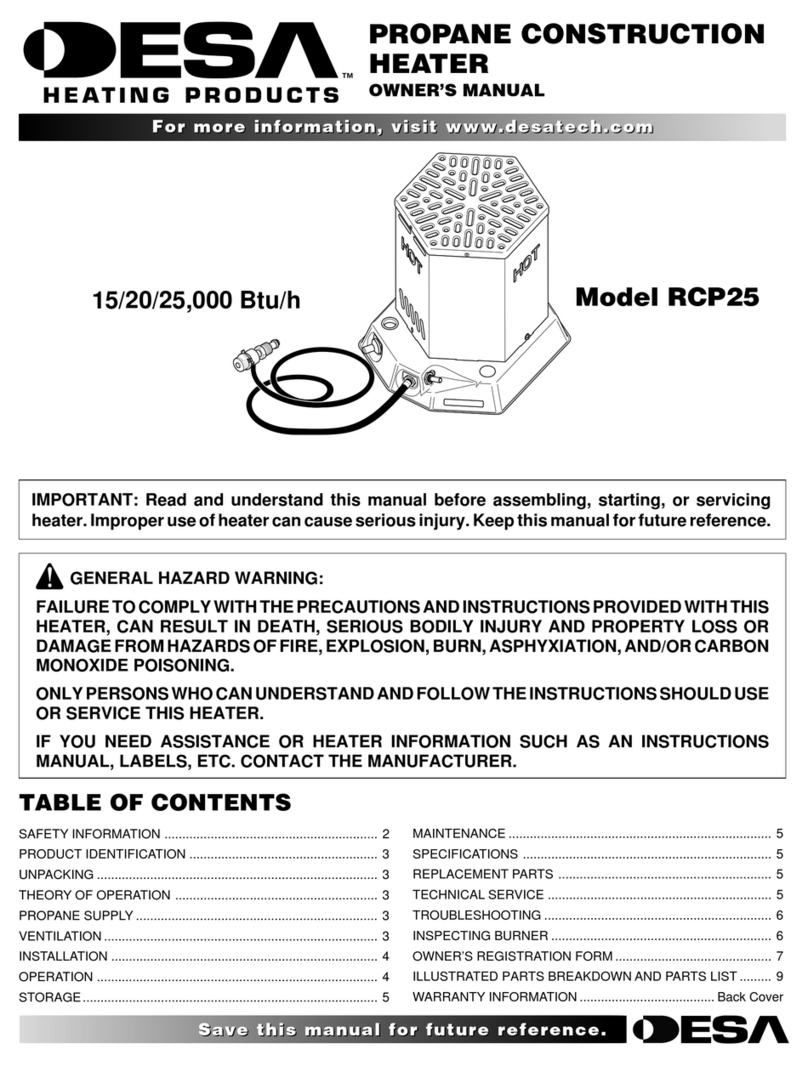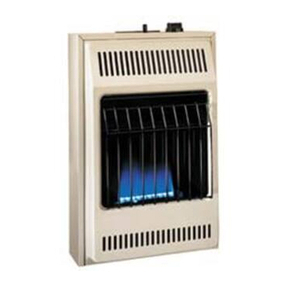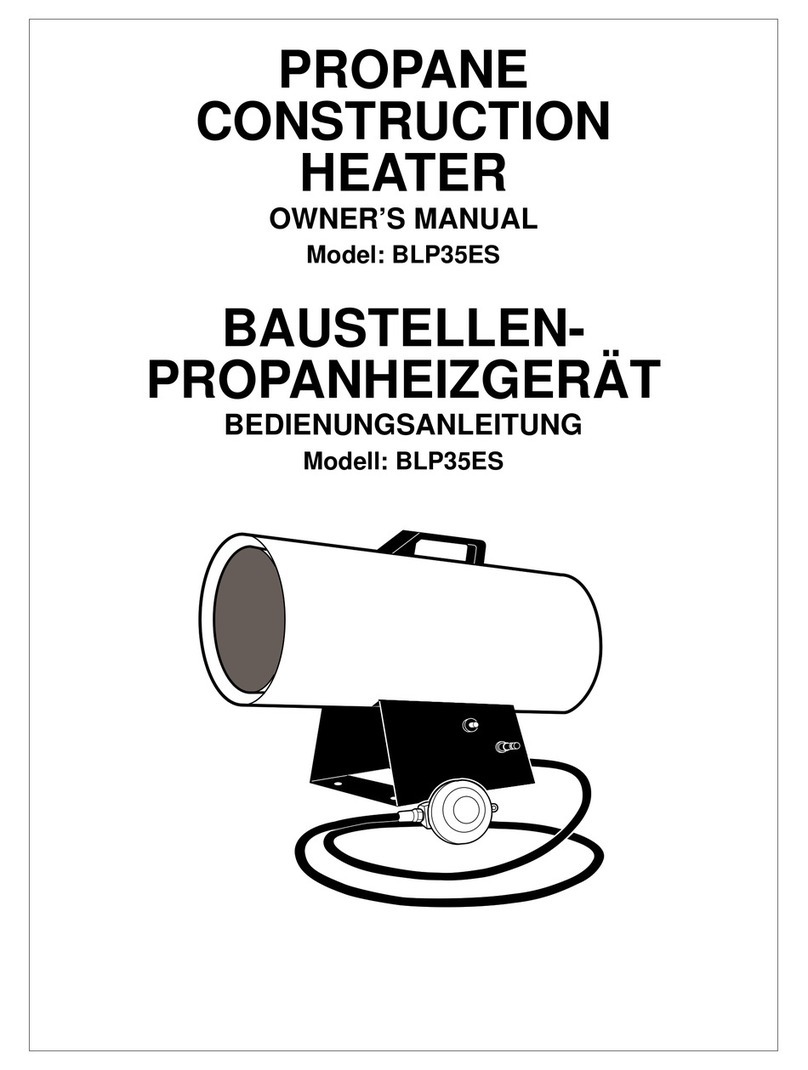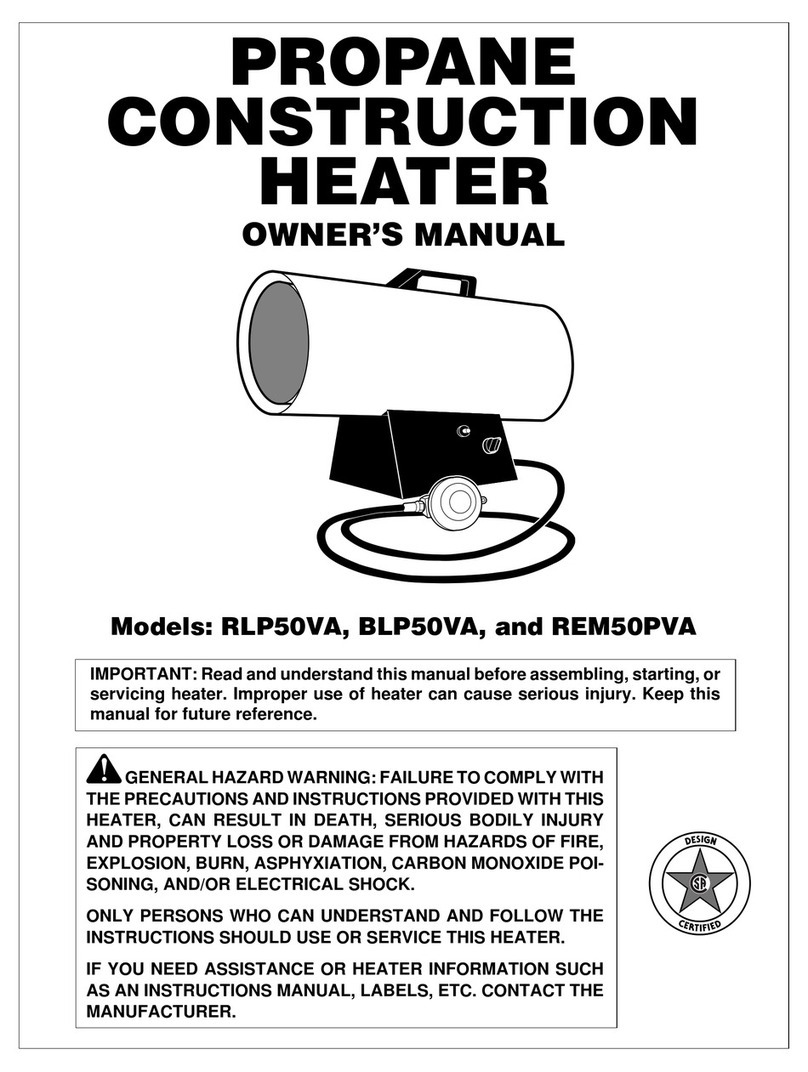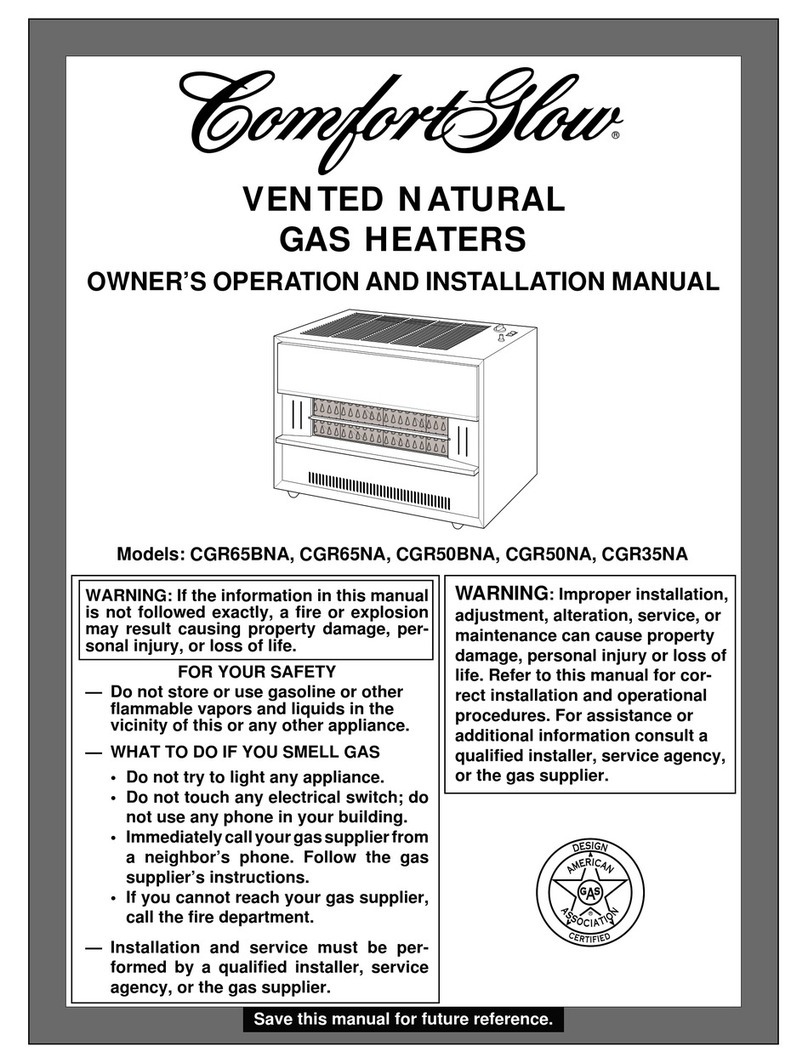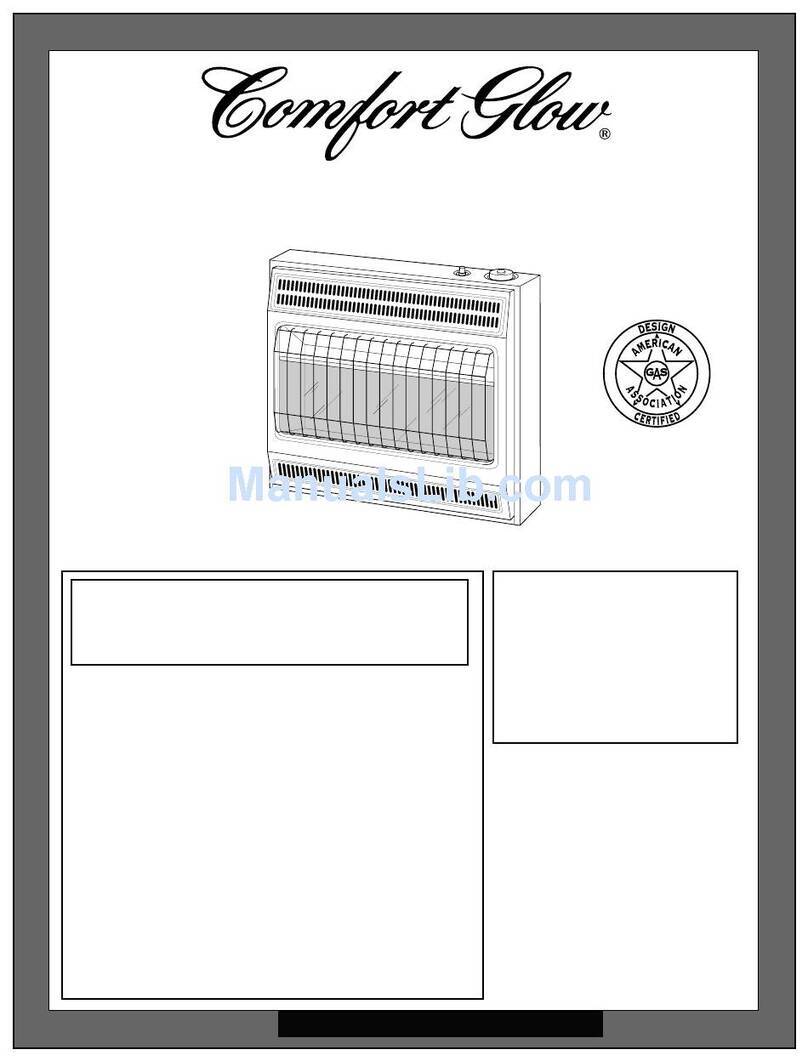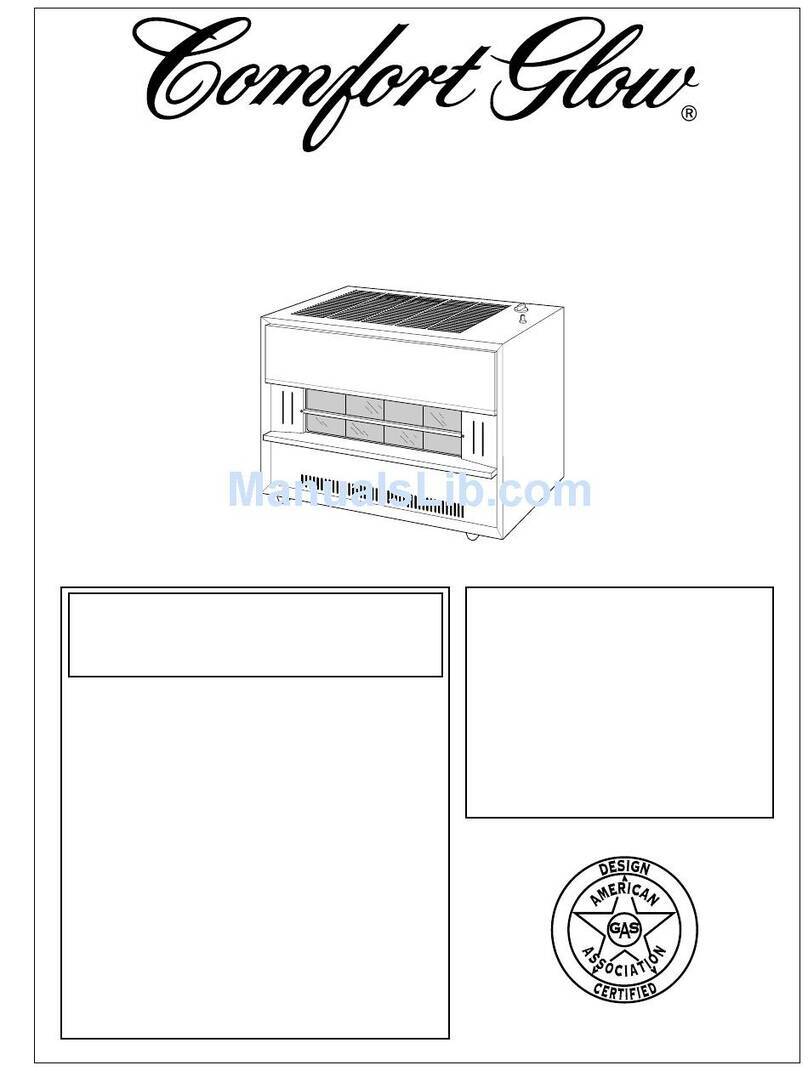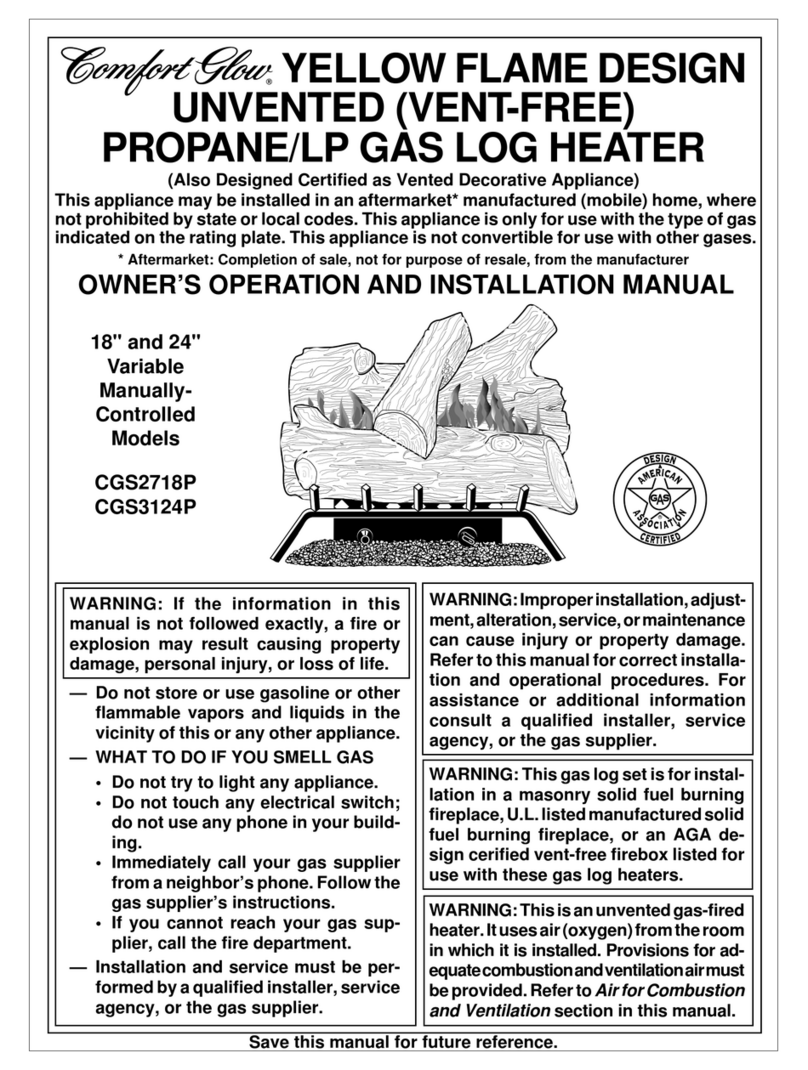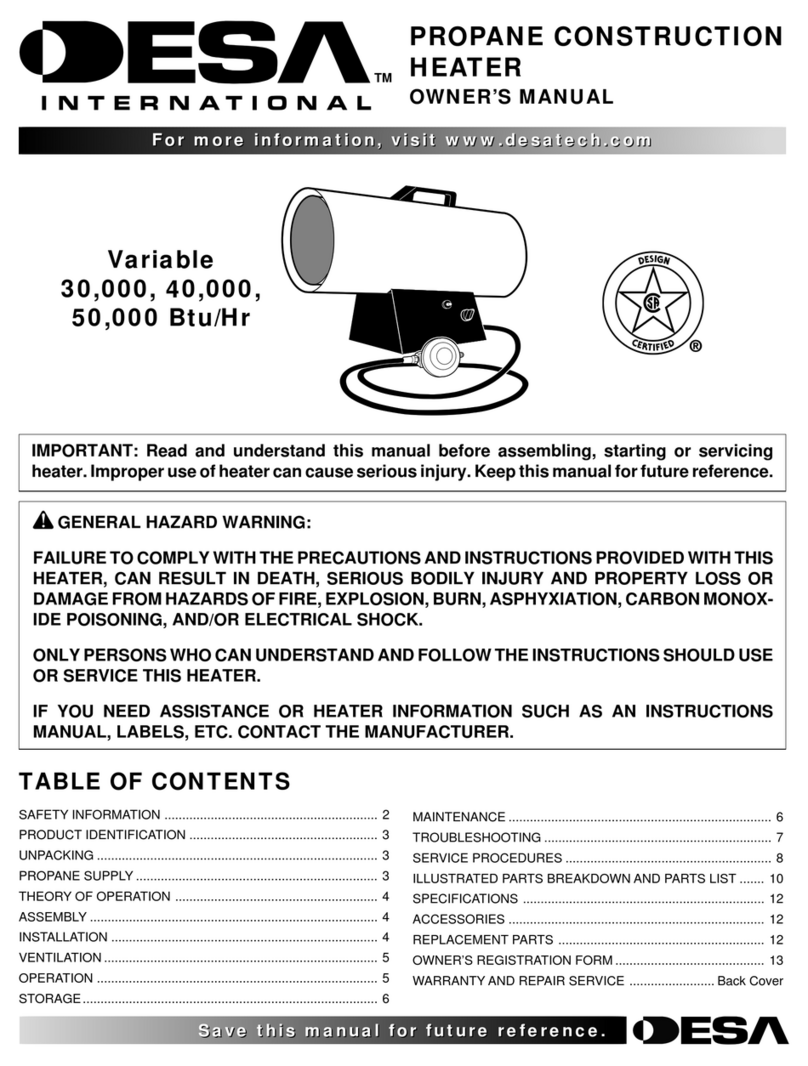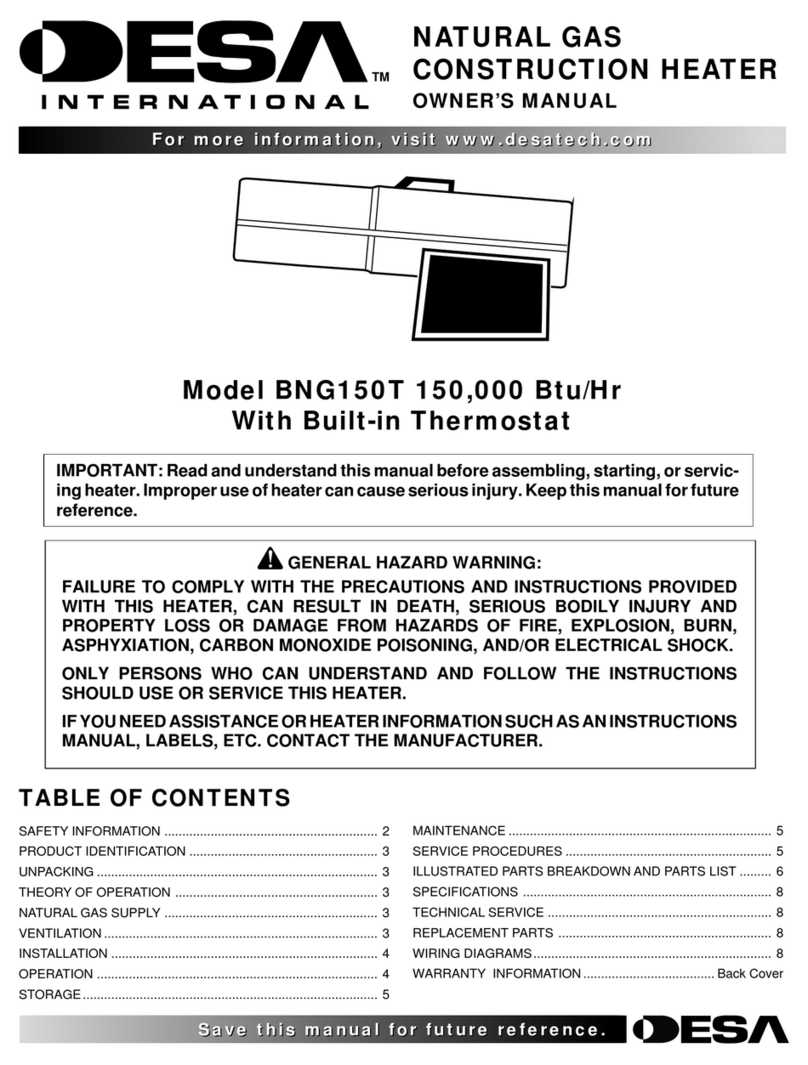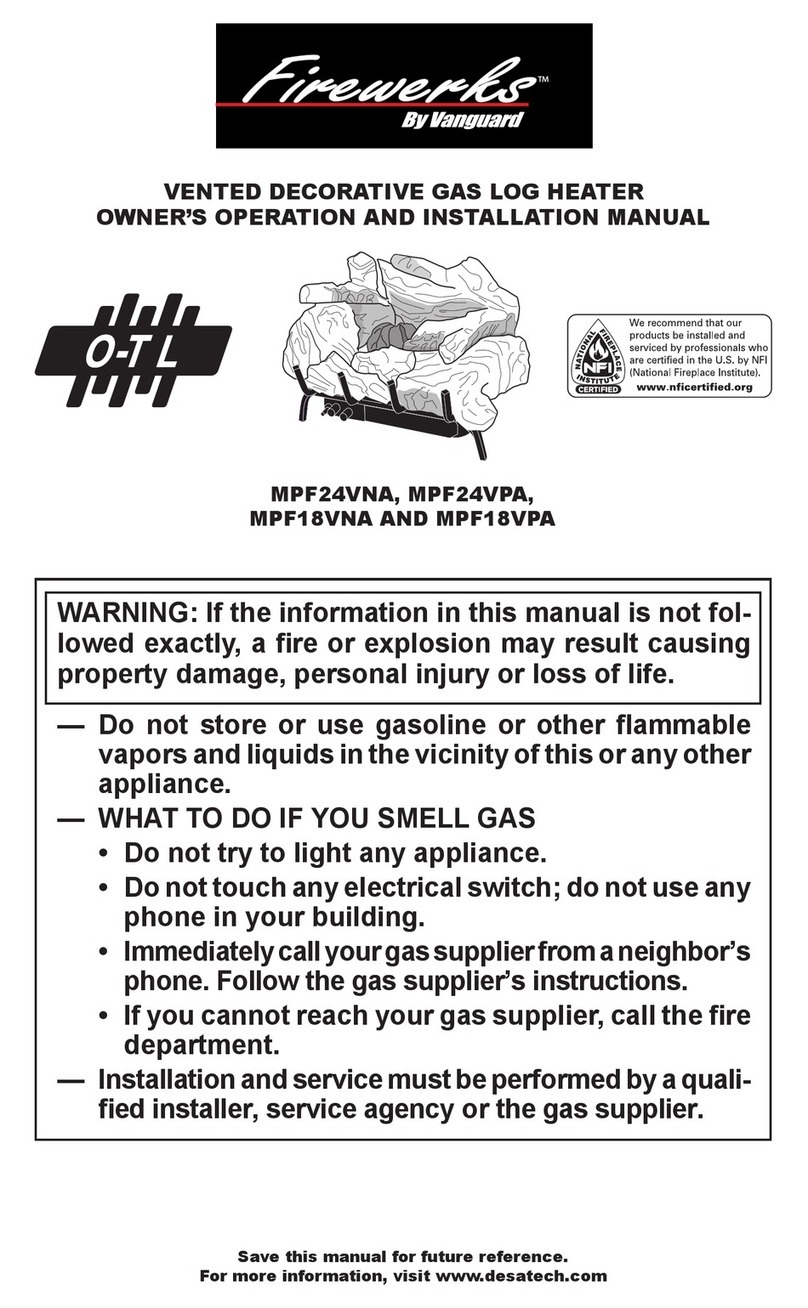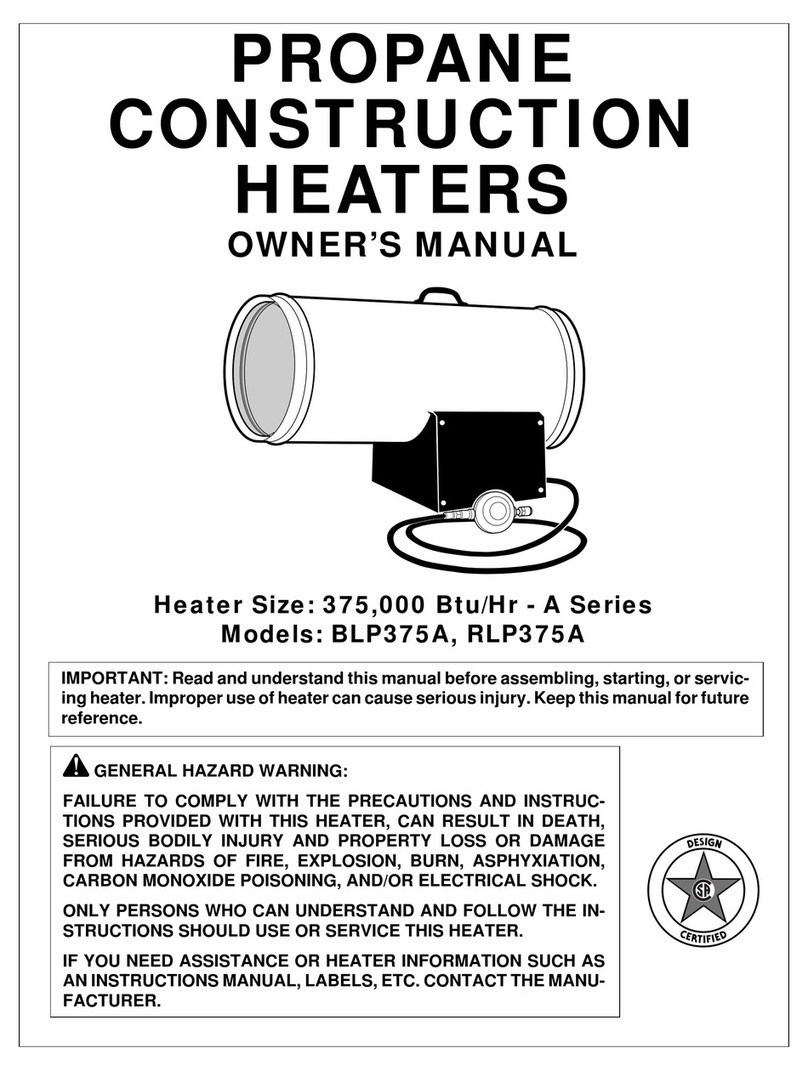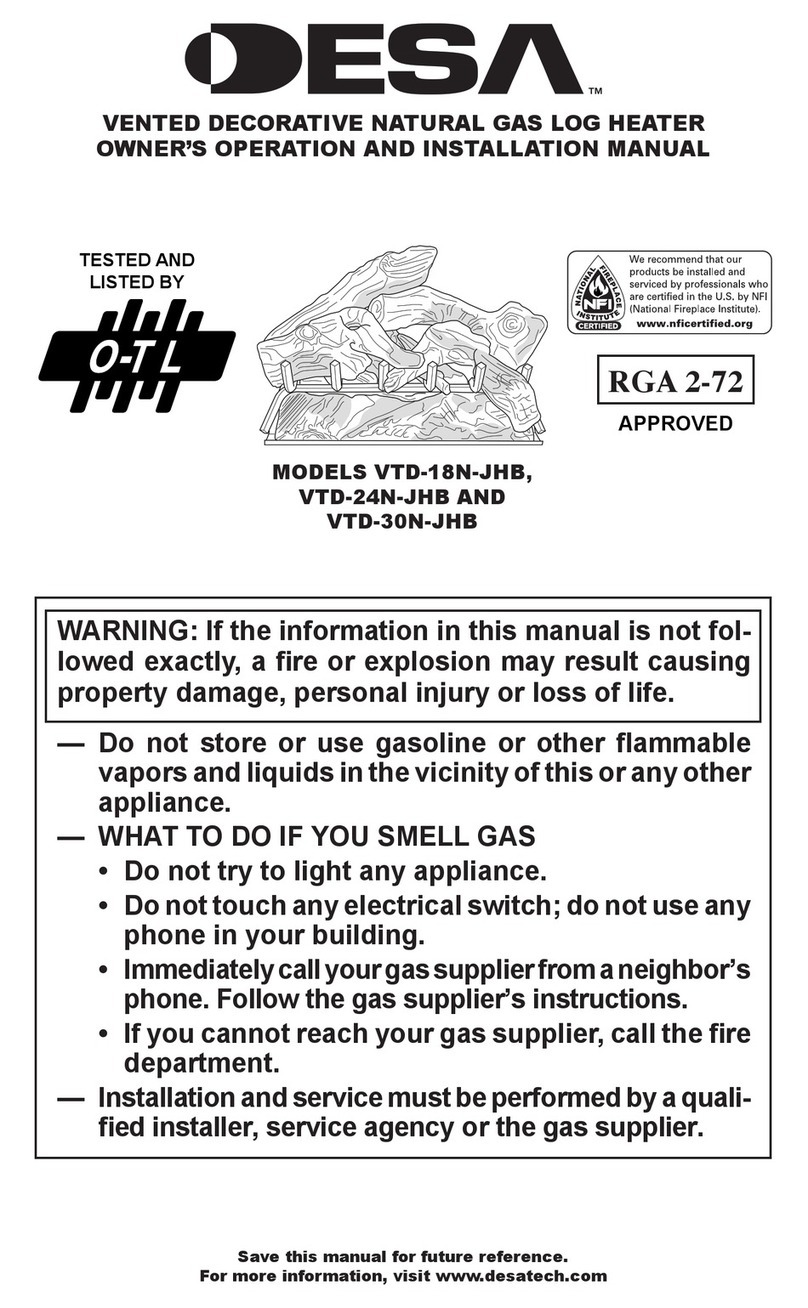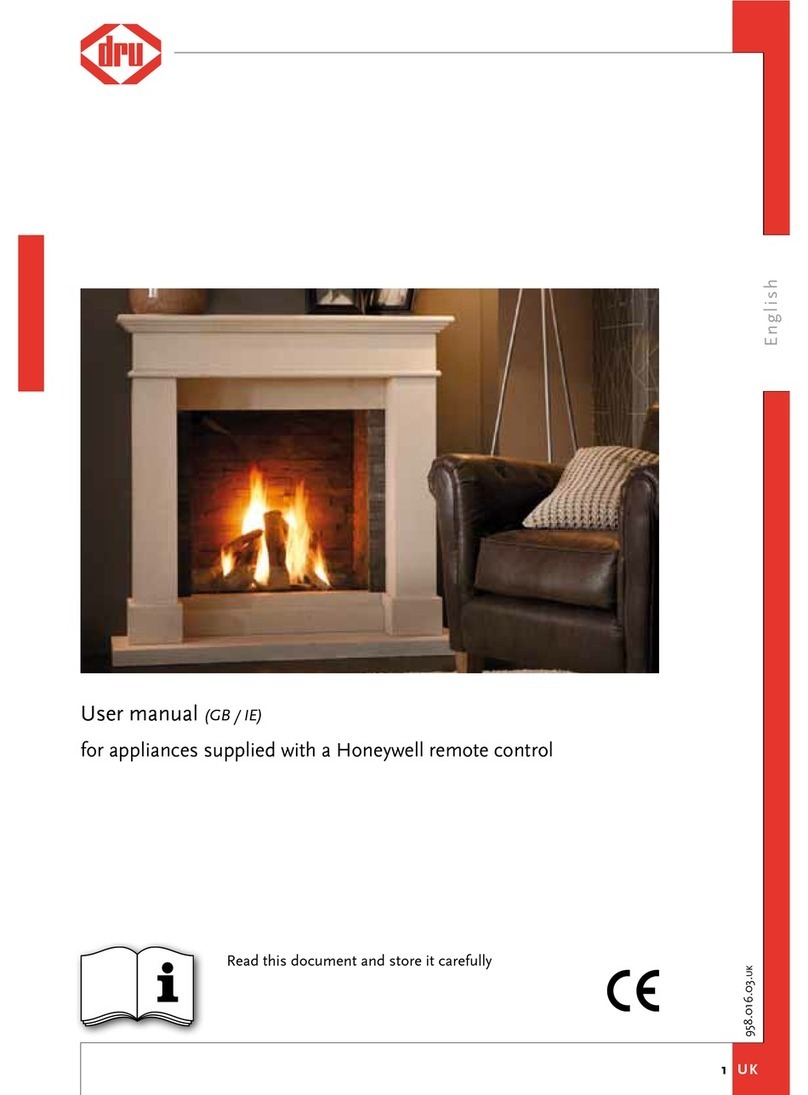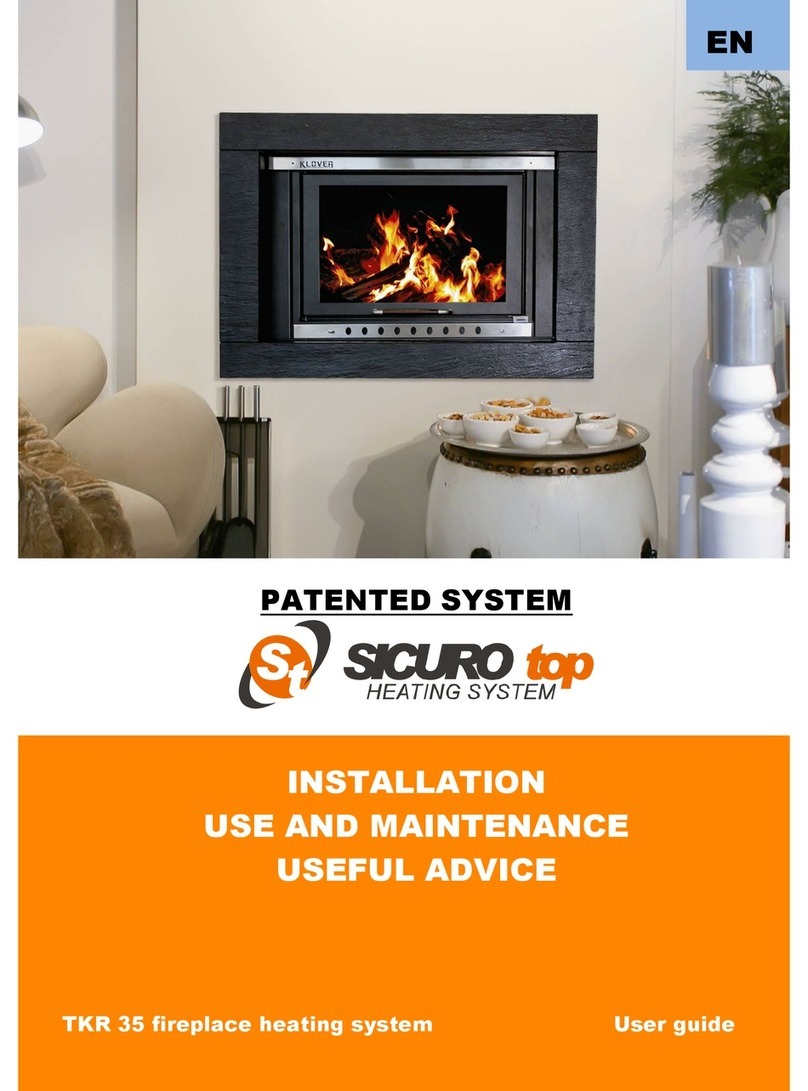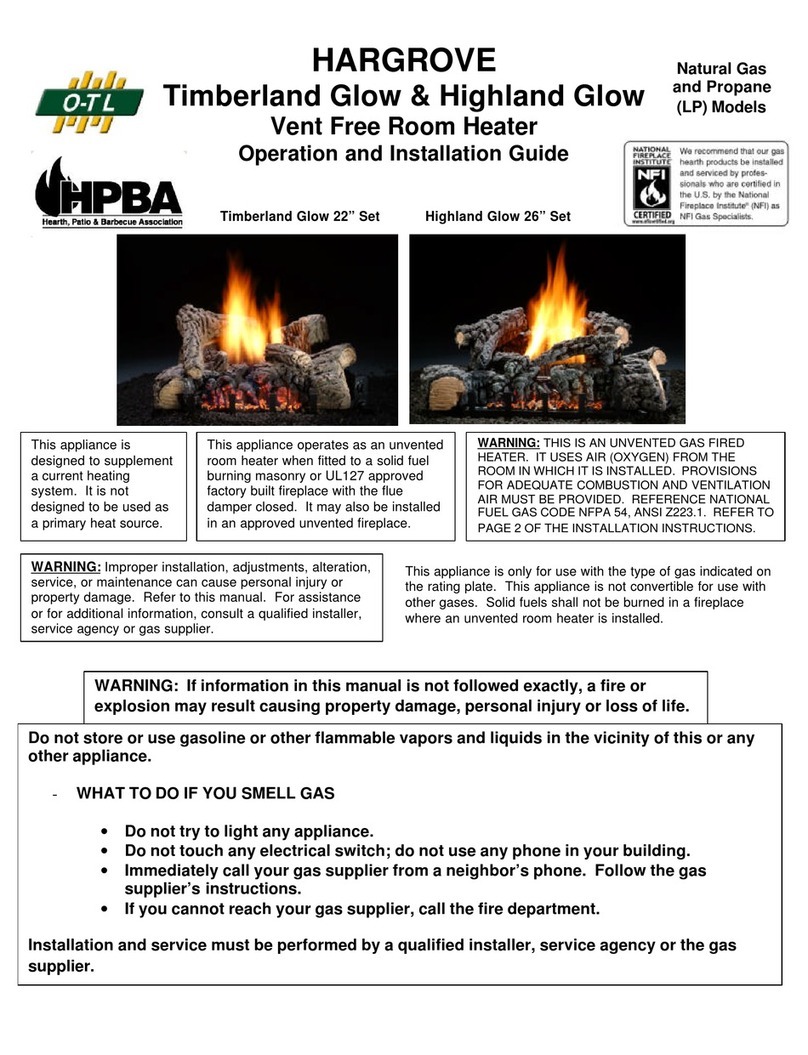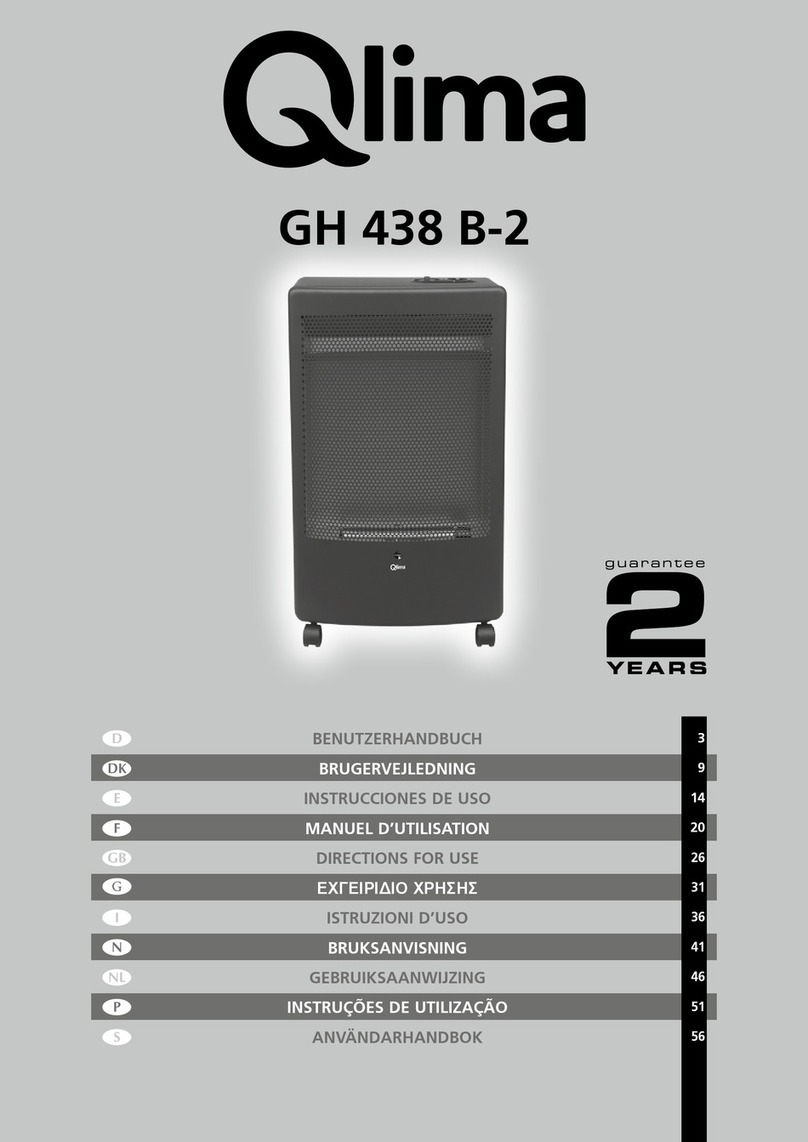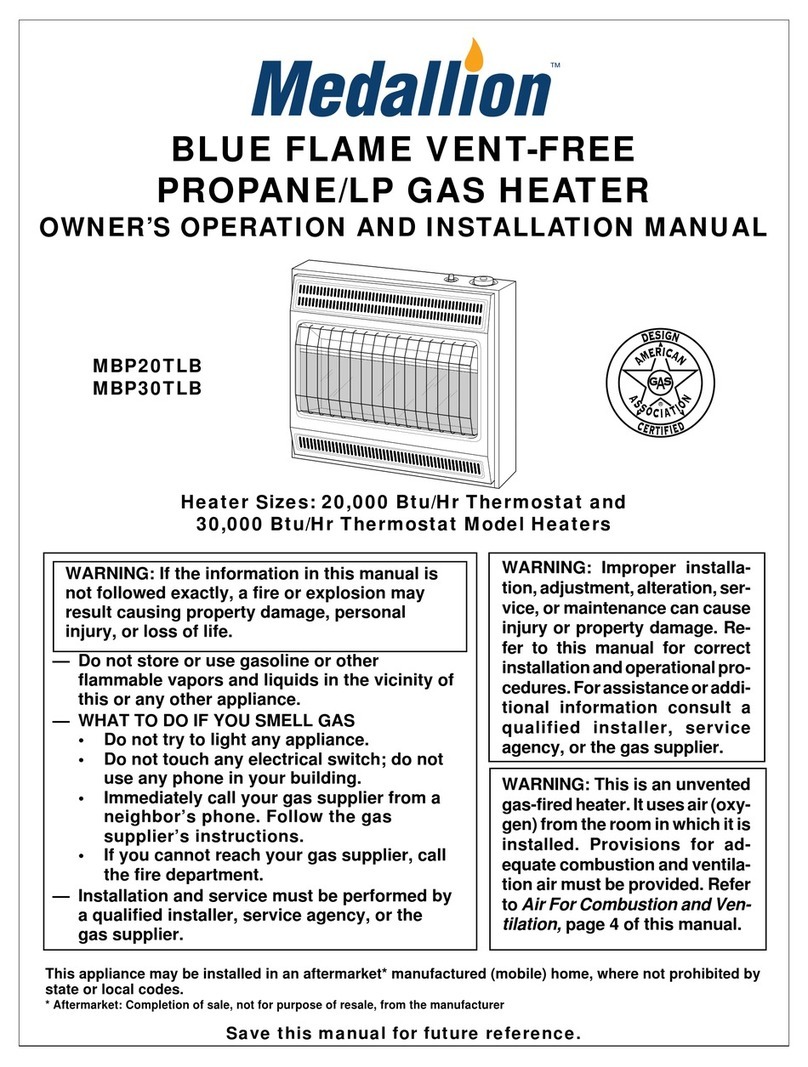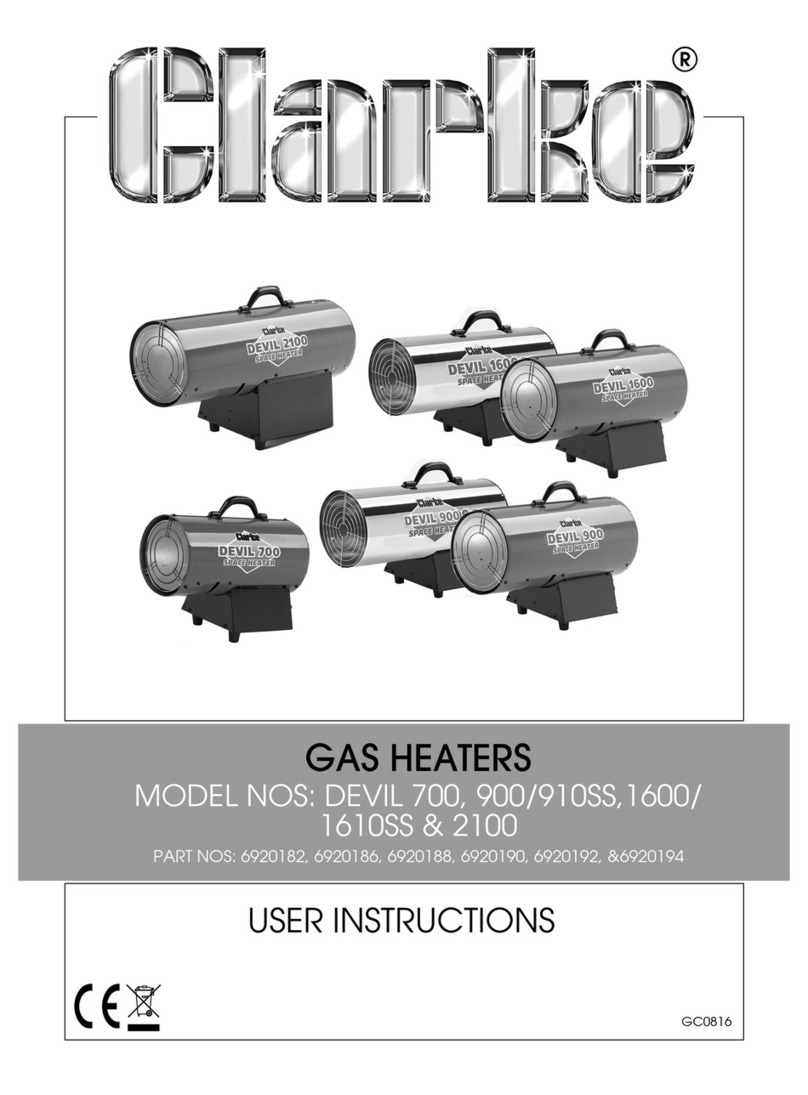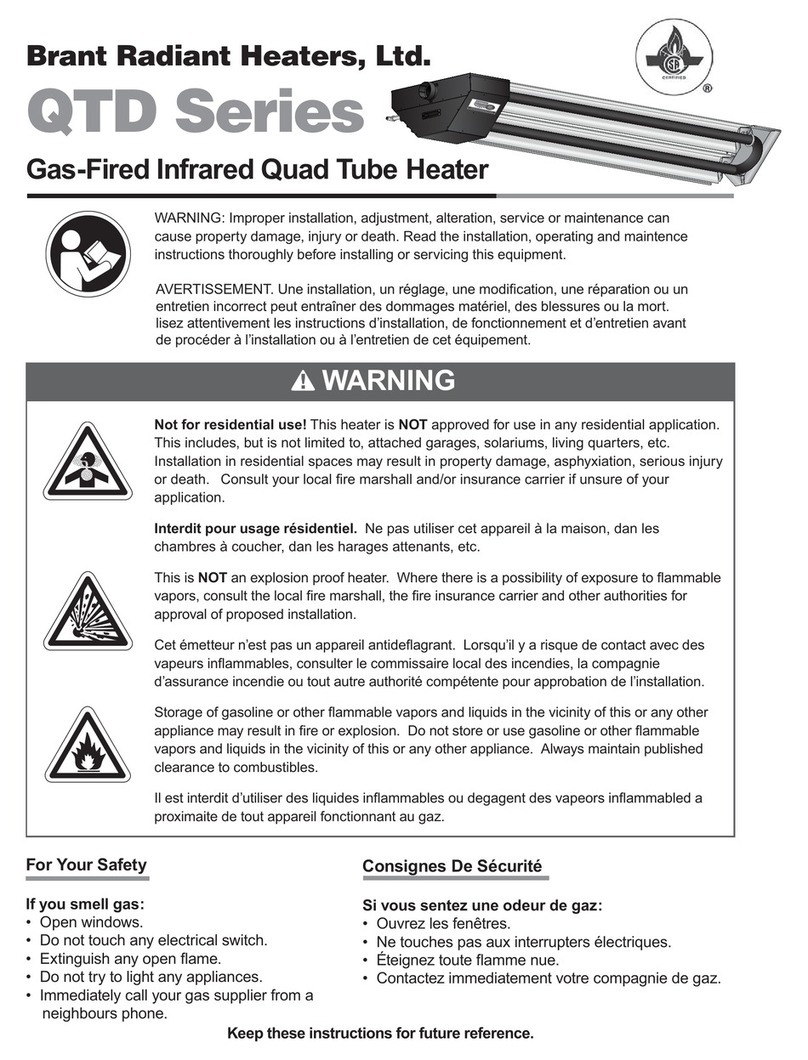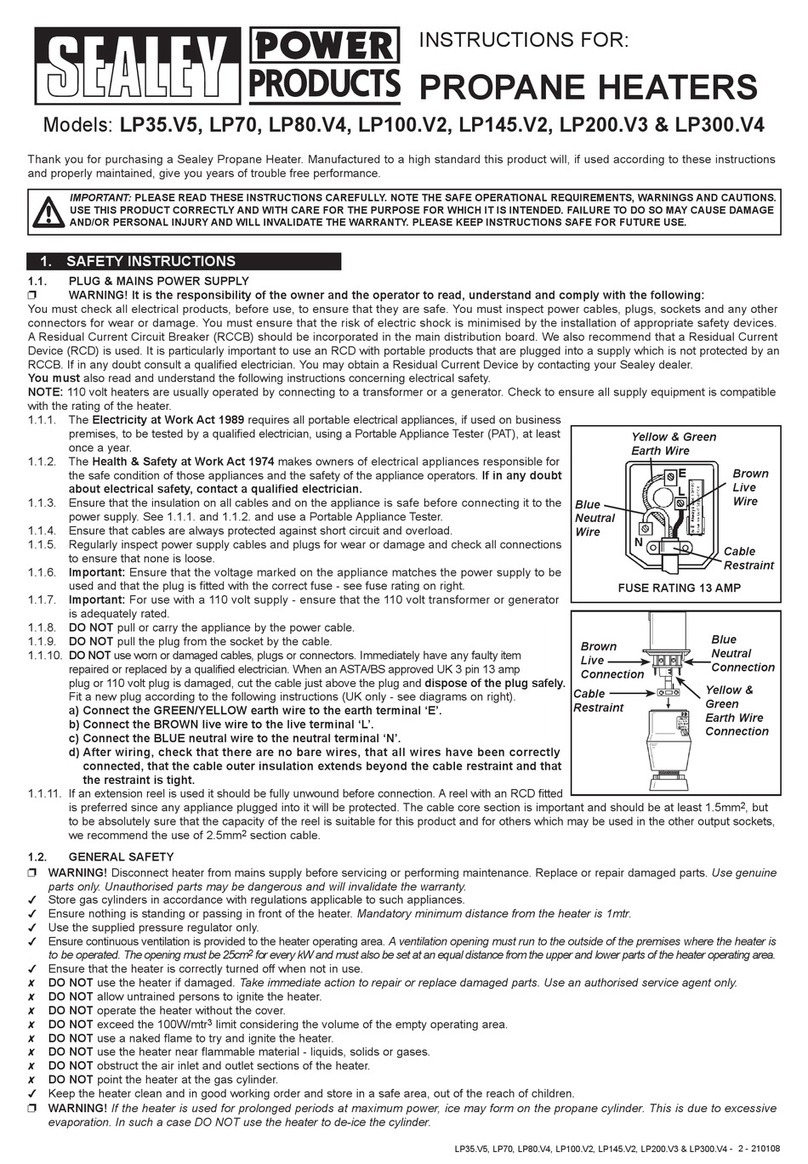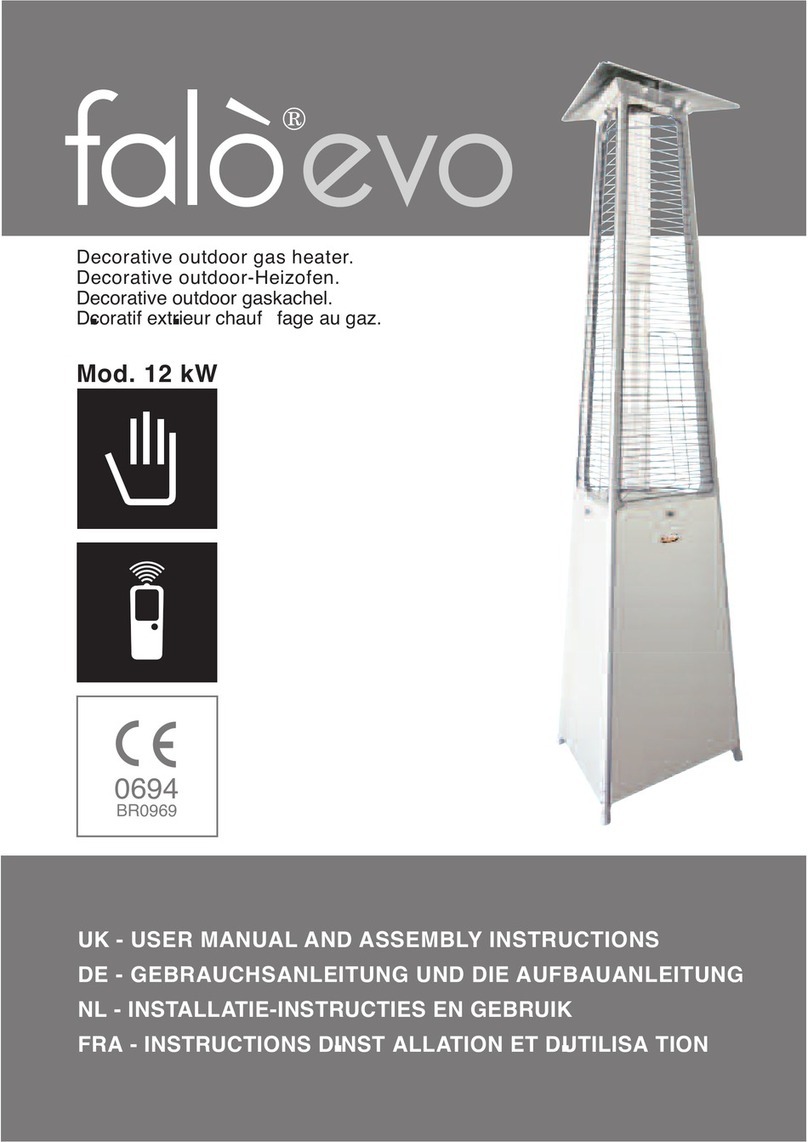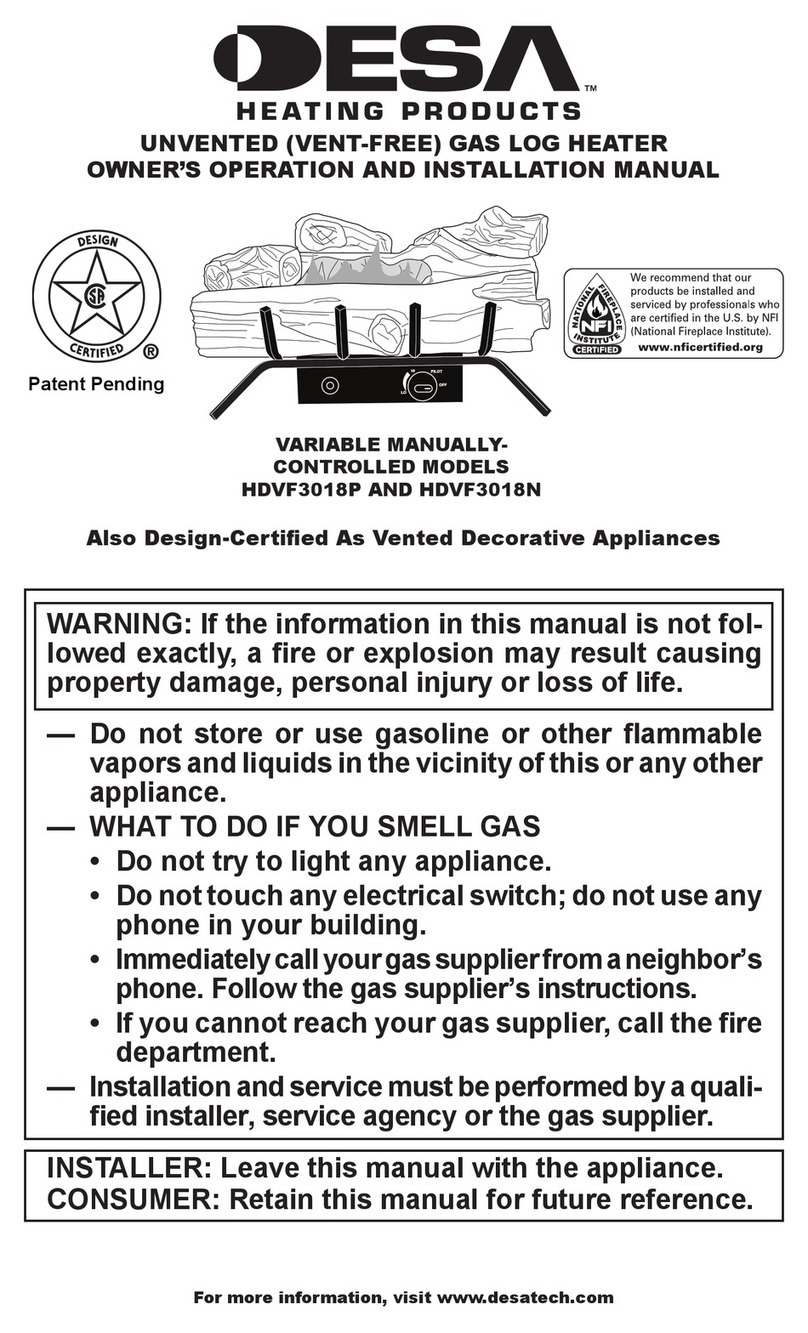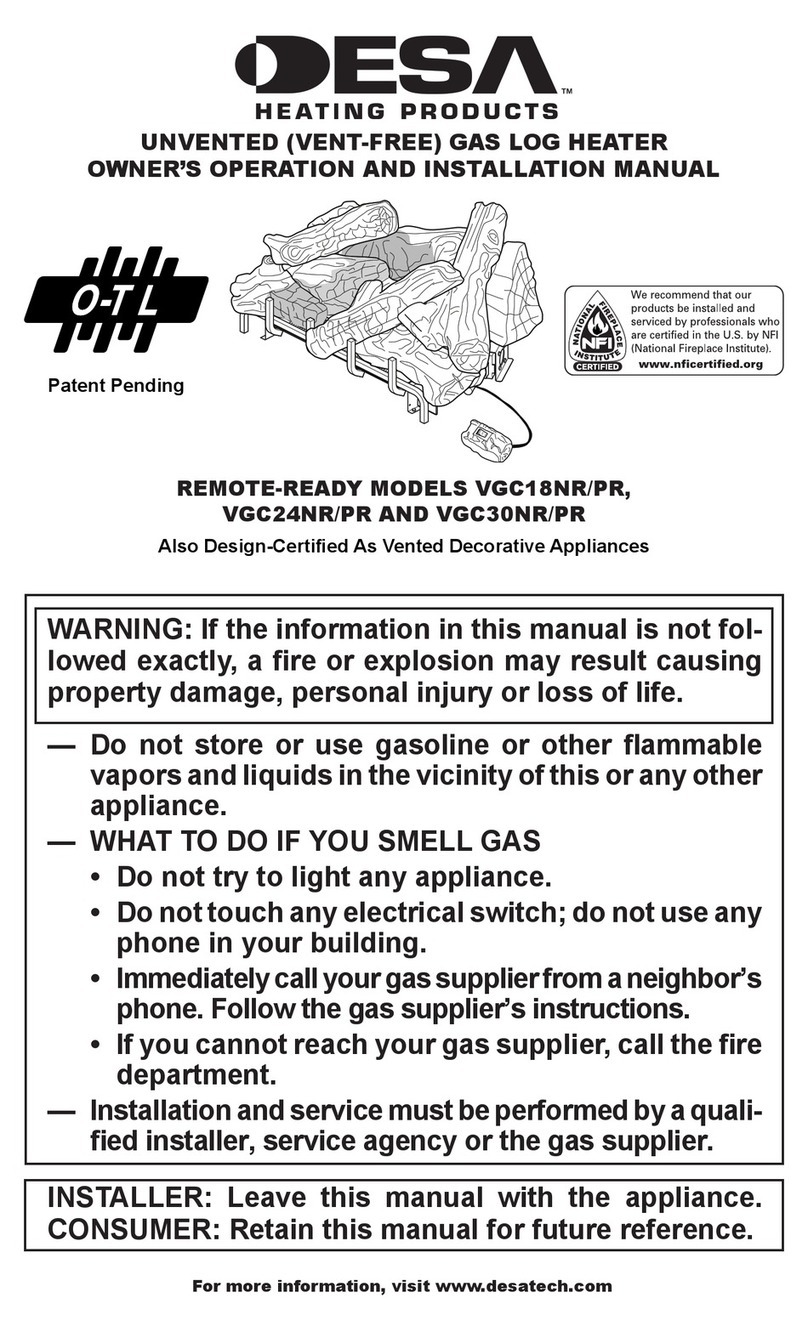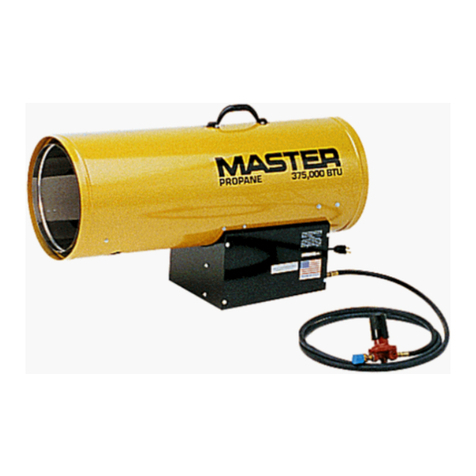
111515-01C
For more information, visit www.desatech.com
For more information, visit www.desatech.com
5
5
AIR FOR COMBUSTION AND VENTILATION
Providing Adequate Ventilation (Cont.)
Determining Fresh-Air Flow for Heater Location
3. Add the Btu/Hr of all fuel burning appliances in the space.
Vent-free heater _____________ Btu/Hr
Gas water heater* _____________ Btu/Hr
Gas furnace _____________ Btu/Hr
Vented gas heater _____________ Btu/Hr
Gas fireplace logs _____________ Btu/Hr
Other gas appliances* + _____________ Btu/Hr
Total = _____________ Btu/Hr
* Do not include direct-vent gas appliances. Direct-vent draws com-
bustion air from the outdoors and vents to the outdoors.
Example:
Gas water heater _____________ Btu/Hr
Vent-free heater + _____________ Btu/Hr
Total = _____________ Btu/Hr
4. Compare the maximum Btu/Hr the space can support with the actual
amount of Btu/Hr used.
__________________ Btu/Hr (maximum the space can support)
__________________ Btu/Hr (actual amount of Btu/Hr used)
Example:
51,200 Btu/Hr (maximum the space can support)
73,000 Btu/Hr (actual amount of Btu/Hr used)
Thespace in the above exampleis a confined space becausethe actual Btu/
Hrusedismorethanthe maximumBtu/Hrthespacecansupport. Youmust
provide additional fresh air. Your options are as follows:
A. Rework worksheet, adding the space of an adjoining room. If the
extra space provides an unconfined space, remove door to adjoining
roomor add ventilation grills betweenrooms. SeeVentilationAir From
Inside Building, page 6.
B. Vent room directly to the outdoors. See Ventilation Air From Out-
doors, page 6.
C. Installa lowerBtu/Hr heater, if lowerBtu/Hr sizemakes roomunconfined.
If the actual Btu/Hr used is less than the maximum Btu/Hr the space can
support, the space is an unconfined space. You will need no additional fresh
air ventilation.
AIR FOR COMBUSTION AND
VENTILATION
Continued
40,000
33,000
73,000
c. caulking or sealants are applied to areas such as
joints around window and door frames,between sole
platesandfloors,betweenwall-ceilingjoints,between
wall panels, at penetrations for plumbing, electrical,
and gas lines, and at other openings.
If your home meets all of the three criteria (a,b, and
c, you must provide additional fresh air. See
Ventila-
tion Air From Outdoors
, page 6
.
If your home does not meet all of the three criteria
above, proceed to
Determining Fresh-Air Flow For
Heater Location
.
Confined and Unconfined Space
The National Fuel Gas Code, ANSI Z223.1/NFPA 54 defines a
confined space as a space whose volume is less than 50 cubic feet
per 1,000 Btu per hour (4.8 m3per kw) of the aggregate input rating
of all appliances installed in that space and an unconfined space as
aspacewhosevolumeisnotlessthan50cubicfeetper1,000Btuper
hour (4.8 m3per kw) of the aggregate input rating of all appliances
installed in that space. Rooms communicating directly with the
space in which the appliances are installed*, through openings not
furnishedwithdoors,areconsideredapartoftheunconfinedspace.
* Adjoining rooms are communicating only if there are doorless
passageways or ventilation grills between them.
DETERMINING FRESH-AIR FLOW FOR
HEATER LOCATION
Determining if You Have a Confined or
Unconfined Space
Usethis worksheetto determineif youhave aconfined orunconfined space.
Space:Includestheroominwhichyouwillinstallheaterplusanyadjoining
rooms with doorless passageways or ventilation grills between the rooms.
1. Determine the volume of the space (length x width x height).
Length x Width x Height = ___________ cu. ft. (volume of space)
Example:
Space size 20 ft. (length) x 16 ft. (width) x 8 ft. (ceiling
height) = 2560 cu. ft. (volume of space)
Ifadditionalventilationtoadjoining roomis suppliedwith grillsor open-
ings, add the volume of these rooms to the total volume of the space.
2. Multiply the space volume by 20 to determine the maximum Btu/Hr
the space can support.
__________ (volume of space) x 20 = (Maximum Btu/Hr the space
can support)
Example:
2560 cu. ft. (volume of space) x 20 = 51,200 (maximum
Btu/Hr the space can support)
WARNING: If the area in which the heater may be
operated is smaller than that defined as an uncon-
fined space or if the building is of unusually tight
construction,provideadequatecombustionandven-
tilation air by one of the methods described in the
National Fuel Gas Code, ANSI Z223.1/NFPA 54 Sec-
tion 5.3
or applicable local codes
.
